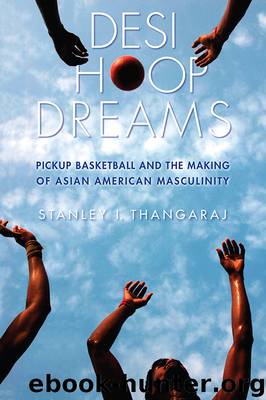Desi Hoop Dreams by Stanley I. Thangaraj

Author:Stanley I. Thangaraj
Language: eng
Format: epub
Tags: SOC002010 Social Science / Anthropology / Cultural
Publisher: New York University Press
Hero Making: Manufacturing Exclusion
Each week, Kdol listed one player in the Asian Ballers League as the “player of the week.” He additionally posted a list on the Asian Ballers website of the top Asian American teams and players nationally. Kdol listed Mustafa as one of the top 10 Asian American basketball players in Atlanta, but Mustafa did not make the national cut. The Atlanta Outkasts and the Atlanta Rat Pack were listed in the top 30 and top 40 Asian American teams, respectively. Regardless of Mustafa’s excellence in the Asian Ballers League, neither he nor any other South Asian Americans infiltrated Kdol’s list of the top 10 Asian American basketball players in the nation. Yet there were Asian American players from Atlanta on the list whose skill sets did not warrant such high rankings.
Both the rankings in Indo-Pak Basketball and the Asian Ballers list provided an opportunity for South Asian American and Asian Americans to celebrate their own co-ethnic peers as heroes. In the Asian Ballers list, the rankings centered on localized Asian American players instead of on traditional collegiate and NBA players. The “player of the week” award, in this case, recognized Asian Americans in Atlanta. After each game, members of the Rat Pack would go to the scorekeeper’s table to check out their own individual stats. With such importance placed on this ranking system, players made it a point to engage in feats of athletic spectacularity that were also quantifiable on the scorer’s sheet—acts such as scoring points, passing (assists), and defense (steals, rebounds, and blocks). The statistical evaluation of players offered explicit and visible recognition that could enhance their basketball status. In fact, Ali’s conversations with the scorer’s table in the middle of games engendered immediate recognition from the persons on the court but also set the stage for possible recognition as the “player of the week.”
The “player of the week” and “top 10” lists ascribed alternate meanings to Asian American bodies by creating a new template of sports heroes. This template did not demand that localized recognition be commonplace in mainstream cultures, even though there was a desire for greater societal appeal. Kdol’s list came about as a result of his familiarity with Asian American communities (mostly Southeast Asian, Chinese, Japanese, Korean, and Filipino Americans) throughout the United States. He did not know the Indo-Pak circuit as intimately. Thus, during one of our conversations, he asked me for contact information for desi tournament organizers in order to collaborate with them to expand the Asian Ballers brand. His request illustrated the particularity of his own social network, which constituted a contained, constrained idea of Asian America. The lack of desi ballers on his list demonstrated fissures in the conception of Asian American–ness that accommodated “brown” Filipino American bodies36 but did not always accommodate South Asian Americans as full members. The list of top 10 players and the weekly awards were products of personal affiliations. Ali did not receive recognition as a “player of the week,” even though players informally recognized him.
Download
This site does not store any files on its server. We only index and link to content provided by other sites. Please contact the content providers to delete copyright contents if any and email us, we'll remove relevant links or contents immediately.
Relentless by Tim S Grover(2027)
Relentless: From Good to Great to Unstoppable by Tim S Grover(1621)
Work On Your Game by Dre Baldwin(1540)
Good Clean Fun by Nick Offerman(1288)
Time's Champion by Time's Champion (Craig Hinton & Chris McKeon)(1233)
The Cities by K.A Knight(1212)
How to Be Like Mike by Pat Williams(1205)
Coach Wooden and Me by Kareem Abdul-Jabbar(1132)
Calisthenics: Core CRUSH: 38 Bodyweight Exercises | The #1 Six Pack Bodyweight Training Guide by Pure Calisthenics(1124)
Friends Lovers and Family by Unknown(1124)
Dream Team by Jack McCallum(1119)
Betaball by Erik Malinowski(1097)
The Blueprint by Jason Lloyd(1083)
The Punch by John Feinstein(1016)
Red and Me by Bill Russell(986)
Long Shots by Jay Bilas(978)
LeBron, Inc. by Windhorst Brian;(977)
Seven Seconds or Less by Jack McCallum(942)
Ruby Ridge(922)
